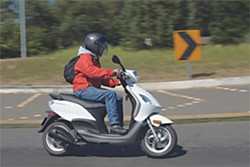[
{
"name": "Top Stories Video Pair",
"insertPoint": "7",
"component": "17087298",
"parentWrapperClass": "fdn-ads-inline-content-block",
"requiredCountToDisplay": "1"
}
]
Riders should be constantly scanning the road ahead for hazards and potential hazards. Debris in the road, like loose gravel or bark from a logging truck, is no problem for a car, but can be disaster for a motorcycle. Pedestrians and other drivers pose their own set of potential problems.
•
Unlike the driver of automobiles, the operator of a motorcycle must balance. Illegal drugs and some legal drugs like antihistamines and sedatives can affect the mental and motor processes needed to ride safely. A rider could be under the legal limit for alcohol and still not be able to safely ride a motorcycle. That is because vision and judgment are two of the first things impaired by alcohol. Both are critical for safe riding.
•
Bright colors and reflective strips on riding gear make it easier for a motorist to spot riders. Williams says one of the biggest mistakes new riders make is their choice of gear. "I see a lot of new riders who choose fashion over visibility," she says.
A rider's gear serves another critical function. Unlike cars and trucks that protect the driver and passengers from injury with seatbelts, air bags and safety cages, a motorcyclist's only protection in a wreck is her riding gear. It might seem like a no-brainer, but the most important piece of safety equipment for riders is their helmet. Most motorcycle fatalities are the result of brain injuries. Students learn about the importance of good riding gear.
•
One way to be more visible on the road is for riders to get modulating head and taillights. These lights flicker while on, and are easier for motorists to see. "Instead of chrome and carbon fiber upgrades, you should be getting modulating head and tail lights," says Jennifer Joell, owner of Redwood Region Motorcycle Training. "You should invest in your safety."
Joell adds that she has been in contact with dealers and is encouraging sales people to suggest these lights.
•
One place riders are taught not to ride is in a car's blind spot. But there's another place where both motorists and riders should not drive. The Department of Transportation calls it the "No-Zone." Tractor-trailers have large blind spots to the right and left and directly behind and in front of the rig.
One student at last month's Basic Driver Course knew just how big those blind spots are. Ron Reynolds recently purchased a motorcycle and was taking the class to get his license. He drives a fuel truck for a living, and had a chilling message for the class about riding in a semi's blind spot: "If I have to change lanes to avoid something and you're in my blind spot, you won't even be a speed bump. I won't feel you." It drove the point home.
•
more from the author
Latest in News
Readers also liked…
-
Through Mark Larson's Lens
A local photographer's favorite images of 2022 in Humboldt
- Jan 5, 2023
-
'To Celebrate Our Sovereignty'
Yurok Tribe to host gathering honoring 'ultimate river warrior' on the anniversary of the U.S. Supreme Court ruling that changed everything
- Jun 8, 2023
































